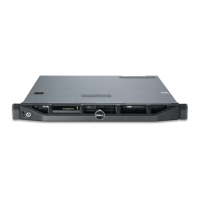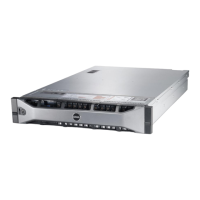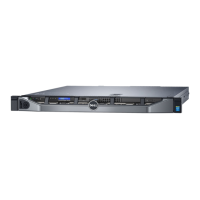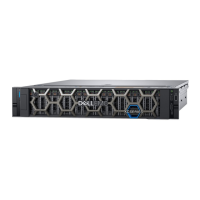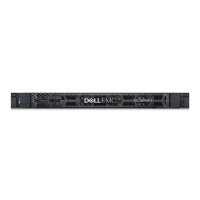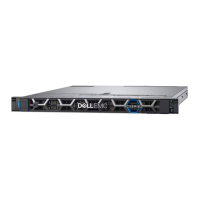Do you have a question about the Dell External OEMR R210II and is the answer not in the manual?
Describes keystrokes for accessing system features like Setup and Boot Manager during startup.
Details the buttons, indicators, and connectors on the system's front panel.
Details the controls, indicators, and connectors on the system's back panel.
Provides instructions and precautions for connecting external devices to the system.
Explains the meaning of different link and activity indicator codes for the Network Interface Card.
Lists diagnostic indicator codes, their causes, and corrective actions for system startup errors.
Explains system messages, their causes, and corrective actions for various system issues.
Describes warning messages that alert users to potential problems before a task continues.
Explains messages that may appear when running system diagnostic utilities.
Describes alert messages generated by systems management software for system conditions.
Provides references to additional documentation and resources for system setup and maintenance.
Explains the BIOS and UEFI boot modes and how to select them for OS installation.
Provides step-by-step instructions on how to enter the system setup program using the F2 key.
Offers guidance on noting and addressing error messages that appear during system boot.
Details the main screen options in the System Setup program and their configurations.
Details the main screen of the System Setup program and its configurable options.
Explains options for configuring system memory size, type, speed, and testing.
Details processor settings such as core speed, bus speed, cache size, and virtualization technology.
Covers options for enabling/disabling integrated SATA controller and ports.
Explains options for setting the boot mode (BIOS/UEFI) and boot sequence.
Details options for enabling/disabling integrated devices like USB ports and NICs.
Describes how to change IRQ assignments for integrated devices and expansion cards.
Covers settings for serial communication devices and console redirection.
Explains options for managing system power usage for CPU, fans, and memory.
Details options for configuring system and setup passwords, and TPM security.
Describes the messages displayed on the Exit screen when leaving the System Setup program.
Provides instructions on how to enter the Boot Manager using the F11 key for boot option management.
Explains how to assign, change, and manage system and setup passwords for security.
Introduces Dell USC, an embedded utility for systems and storage management tasks.
Explains how the BMC enables remote configuration, monitoring, and recovery of systems.
Describes the pre-boot environment for viewing and setting parameters for iDRAC6 and the managed server.
Lists essential tools required for installing system components, including screwdrivers and a grounding strap.
Provides an overview diagram of the system's internal components and their locations.
Details the procedure for removing and installing the optional front bezel of the system.
Provides instructions on how to safely open and close the system chassis for component access.
Describes the process of removing and installing an optional optical drive.
Explains the purpose of filler panels and how to remove them before installing an optical drive.
Covers the removal and installation of 3.5-inch SAS or SATA hard drives.
Details installation guidelines, removal, and installation procedures for PCIe expansion cards.
Explains how to remove and install the expansion-card riser that supports PCIe cards.
Describes how to install and use an internal USB memory key as a boot or storage device.
Covers the removal and installation of the cooling shroud that directs airflow to system components.
Provides guidelines for installing and configuring DDR3 DIMMs for optimal performance.
Explains the system's cooling fans and the procedure for removing and installing them.
Details the process for installing and removing the optional iDRAC6 Express card.
Describes how to install and remove the optional iDRAC6 Enterprise card.
Explains how to install and remove a VFlash media card into the iDRAC6 Enterprise card.
Covers the procedure for removing and installing the system processor and heat sink.
Details the steps for removing and installing the 250 W power supply module.
Provides instructions for replacing the system battery.
Describes the procedure for removing and installing the front control panel assembly.
Covers the process of removing and installing the system board, including component transfer.
Emphasizes safety precautions before performing any troubleshooting or repairs on the system.
Guides users through diagnosing and resolving issues that prevent the system from starting up correctly.
Provides steps to ensure external cables are properly connected before troubleshooting devices.
Offers steps to diagnose and resolve problems related to the system's video output and display.
Provides steps for troubleshooting issues with USB devices like keyboards and mice.
Offers guidance on diagnosing and resolving problems with serial port devices.
Covers steps for diagnosing and resolving issues with the Network Interface Card (NIC).
Provides instructions for handling and troubleshooting systems exposed to liquid damage.
Outlines steps for troubleshooting a system that may have suffered physical damage.
Guides users on how to diagnose and resolve issues related to the system battery.
Covers steps to diagnose and resolve problems related to the system's power supply unit.
Details common causes and checks for system overheating and cooling issues.
Provides steps for diagnosing and resolving problems with individual system cooling fans.
Guides users through diagnosing and resolving issues related to system memory modules.
Offers steps for diagnosing and resolving problems with internal USB memory keys.
Provides steps for diagnosing and resolving issues with the system's optical drive.
Covers procedures for diagnosing and resolving problems with hard drives, including RAID arrays.
Details steps for diagnosing and resolving issues with installed expansion cards.
Guides users through diagnosing and resolving issues related to the system processor.
Explains how to use Dell's online diagnostics suite to test system hardware components.
Describes the capabilities and features of the embedded system diagnostics program.
Explains when to use embedded diagnostics, typically when major components fail but I/O is functional.
Provides step-by-step instructions to launch and run the embedded system diagnostics.
Outlines the different testing options available within the system diagnostics.
Describes the Express Test for a quick system check that requires no user interaction.
Explains the Extended Test for a more thorough system check that may take longer.
Details how to select specific devices and options for custom testing.
Explains how to view test results, errors, and help information within the diagnostics.
Illustrates and describes the configuration jumpers on the system board and their settings.
Provides diagrams and descriptions of various connectors found on the system board.
Explains how to reset system and setup passwords by using the password jumper.
Provides contact information and resources for obtaining technical support and assistance from Dell.
Describes keystrokes for accessing system features like Setup and Boot Manager during startup.
Details the buttons, indicators, and connectors on the system's front panel.
Details the controls, indicators, and connectors on the system's back panel.
Provides instructions and precautions for connecting external devices to the system.
Explains the meaning of different link and activity indicator codes for the Network Interface Card.
Lists diagnostic indicator codes, their causes, and corrective actions for system startup errors.
Explains system messages, their causes, and corrective actions for various system issues.
Describes warning messages that alert users to potential problems before a task continues.
Explains messages that may appear when running system diagnostic utilities.
Describes alert messages generated by systems management software for system conditions.
Provides references to additional documentation and resources for system setup and maintenance.
Explains the BIOS and UEFI boot modes and how to select them for OS installation.
Provides step-by-step instructions on how to enter the system setup program using the F2 key.
Offers guidance on noting and addressing error messages that appear during system boot.
Details the main screen options in the System Setup program and their configurations.
Details the main screen of the System Setup program and its configurable options.
Explains options for configuring system memory size, type, speed, and testing.
Details processor settings such as core speed, bus speed, cache size, and virtualization technology.
Covers options for enabling/disabling integrated SATA controller and ports.
Explains options for setting the boot mode (BIOS/UEFI) and boot sequence.
Details options for enabling/disabling integrated devices like USB ports and NICs.
Describes how to change IRQ assignments for integrated devices and expansion cards.
Covers settings for serial communication devices and console redirection.
Explains options for managing system power usage for CPU, fans, and memory.
Details options for configuring system and setup passwords, and TPM security.
Describes the messages displayed on the Exit screen when leaving the System Setup program.
Provides instructions on how to enter the Boot Manager using the F11 key for boot option management.
Explains how to assign, change, and manage system and setup passwords for security.
Introduces Dell USC, an embedded utility for systems and storage management tasks.
Explains how the BMC enables remote configuration, monitoring, and recovery of systems.
Describes the pre-boot environment for viewing and setting parameters for iDRAC6 and the managed server.
Lists essential tools required for installing system components, including screwdrivers and a grounding strap.
Provides an overview diagram of the system's internal components and their locations.
Details the procedure for removing and installing the optional front bezel of the system.
Provides instructions on how to safely open and close the system chassis for component access.
Describes the process of removing and installing an optional optical drive.
Explains the purpose of filler panels and how to remove them before installing an optical drive.
Covers the removal and installation of 3.5-inch SAS or SATA hard drives.
Details installation guidelines, removal, and installation procedures for PCIe expansion cards.
Explains how to remove and install the expansion-card riser that supports PCIe cards.
Describes how to install and use an internal USB memory key as a boot or storage device.
Covers the removal and installation of the cooling shroud that directs airflow to system components.
Provides guidelines for installing and configuring DDR3 DIMMs for optimal performance.
Explains the system's cooling fans and the procedure for removing and installing them.
Details the process for installing and removing the optional iDRAC6 Express card.
Describes how to install and remove the optional iDRAC6 Enterprise card.
Explains how to install and remove a VFlash media card into the iDRAC6 Enterprise card.
Covers the procedure for removing and installing the system processor and heat sink.
Details the steps for removing and installing the 250 W power supply module.
Provides instructions for replacing the system battery.
Describes the procedure for removing and installing the front control panel assembly.
Covers the process of removing and installing the system board, including component transfer.
Emphasizes safety precautions before performing any troubleshooting or repairs on the system.
Guides users through diagnosing and resolving issues that prevent the system from starting up correctly.
Provides steps to ensure external cables are properly connected before troubleshooting devices.
Offers steps to diagnose and resolve problems related to the system's video output and display.
Provides steps for troubleshooting issues with USB devices like keyboards and mice.
Offers guidance on diagnosing and resolving problems with serial port devices.
Covers steps for diagnosing and resolving issues with the Network Interface Card (NIC).
Provides instructions for handling and troubleshooting systems exposed to liquid damage.
Outlines steps for troubleshooting a system that may have suffered physical damage.
Guides users on how to diagnose and resolve issues related to the system battery.
Covers steps to diagnose and resolve problems related to the system's power supply unit.
Details common causes and checks for system overheating and cooling issues.
Provides steps for diagnosing and resolving problems with individual system cooling fans.
Guides users through diagnosing and resolving issues related to system memory modules.
Offers steps for diagnosing and resolving problems with internal USB memory keys.
Provides steps for diagnosing and resolving issues with the system's optical drive.
Covers procedures for diagnosing and resolving problems with hard drives, including RAID arrays.
Details steps for diagnosing and resolving issues with installed expansion cards.
Guides users through diagnosing and resolving issues related to the system processor.
Explains how to use Dell's online diagnostics suite to test system hardware components.
Describes the capabilities and features of the embedded system diagnostics program.
Explains when to use embedded diagnostics, typically when major components fail but I/O is functional.
Provides step-by-step instructions to launch and run the embedded system diagnostics.
Outlines the different testing options available within the system diagnostics.
Describes the Express Test for a quick system check that requires no user interaction.
Explains the Extended Test for a more thorough system check that may take longer.
Details how to select specific devices and options for custom testing.
Explains how to view test results, errors, and help information within the diagnostics.
Illustrates and describes the configuration jumpers on the system board and their settings.
Provides diagrams and descriptions of various connectors found on the system board.
Explains how to reset system and setup passwords by using the password jumper.
Provides contact information and resources for obtaining technical support and assistance from Dell.
| Memory Slots | 4 DIMM slots |
|---|---|
| Form Factor | 1U rack |
| Network | Dual Gigabit Ethernet |
| Processor | Intel Xeon E3-1200 series |
| Chipset | Intel C202 |
| Memory | Up to 32GB DDR3 ECC Unbuffered or Non-ECC Unbuffered |
| RAID Support | PERC H200 |
| Drive Bays | Up to 4 x 3.5” or 2.5” |
| Power Supply | 250W non-redundant power supply |
| Network Controller | Broadcom BCM5722 |
| Expansion Slots | 1 x PCIe x16 slot (x16 connector) |
| Operating System Support | Red Hat Enterprise Linux, SUSE Linux Enterprise Server |
